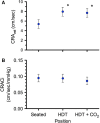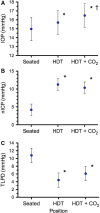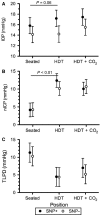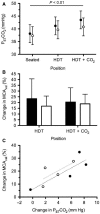Effects of short-term mild hypercapnia during head-down tilt on intracranial pressure and ocular structures in healthy human subjects
- PMID: 28611153
- PMCID: PMC5471441
- DOI: 10.14814/phy2.13302
Effects of short-term mild hypercapnia during head-down tilt on intracranial pressure and ocular structures in healthy human subjects
Abstract
Many astronauts experience ocular structural and functional changes during long-duration spaceflight, including choroidal folds, optic disc edema, globe flattening, optic nerve sheath diameter (ONSD) distension, retinal nerve fiber layer thickening, and decreased visual acuity. The leading hypothesis suggests that weightlessness-induced cephalad fluid shifts increase intracranial pressure (ICP), which contributes to the ocular structural changes, but elevated ambient CO2 levels on the International Space Station may also be a factor. We used the spaceflight analog of 6° head-down tilt (HDT) to investigate possible mechanisms for ocular changes in eight male subjects during three 1-h conditions: Seated, HDT, and HDT with 1% inspired CO2 (HDT + CO2). Noninvasive ICP, intraocular pressure (IOP), translaminar pressure difference (TLPD = IOP-ICP), cerebral and ocular ultrasound, and optical coherence tomography (OCT) scans of the macula and the optic disc were obtained. Analysis of one-carbon pathway genetics previously associated with spaceflight-induced ocular changes was conducted. Relative to Seated, IOP and ICP increased and TLPD decreased during HDT During HDT + CO2 IOP increased relative to HDT, but there was no significant difference in TLPD between the HDT conditions. ONSD and subfoveal choroidal thickness increased during HDT relative to Seated, but there was no difference between HDT and HDT + CO2 Visual acuity and ocular structures assessed with OCT imaging did not change across conditions. Genetic polymorphisms were associated with differences in IOP, ICP, and end-tidal PCO2 In conclusion, acute exposure to mild hypercapnia during HDT did not augment cardiovascular outcomes, ICP, or TLPD relative to the HDT condition.
Keywords: NASA; Head‐down tilt; hypercapnia; one‐carbon metabolism; translaminar pressure difference.
Published 2017. This article is a U.S. Government work and is in the public domain in the USA.
Figures








References
-
- Alexander, D. J. , Gibson C. R., Hamilton D. R., Lee S. M. C., Mader T. H., Otto C., et al. 2012. Evidence report: risk of spaceflight‐induced intracranial hypertension and vision alterations [Online]. Human health and countermeasures, NASA human research program. Available at: https://humanresearchroadmap.nasa.gov/Evidence/reports/VIIP.pdf (accessed 31 March 2017)
-
- Anderson, A. P. , Swan J. G., Phillips S. D., Knaus D. A., Kattamis N. T., Toutain‐Kidd C. M., et al. 2016. Acute effects of changes to the gravitational vector on the eye. J. Appl. Physiol. 120:939–946. - PubMed
-
- Awad, H. , Santilli S., Ohr M., Roth A., Yan W., Fernandez S., et al. 2009. The effects of steep trendelenburg positioning on intraocular pressure during robotic radical prostatectomy. Anesth. Analg. 109:473–478. - PubMed
-
- Berdahl, J. P. , Yu D. Y., and Morgan W. H.. 2012. The translaminar pressure gradient in sustained zero gravity, idiopathic intracranial hypertension, and glaucoma. Med. Hypotheses 79:719–724. - PubMed
MeSH terms
LinkOut - more resources
Full Text Sources
Other Literature Sources
Medical

